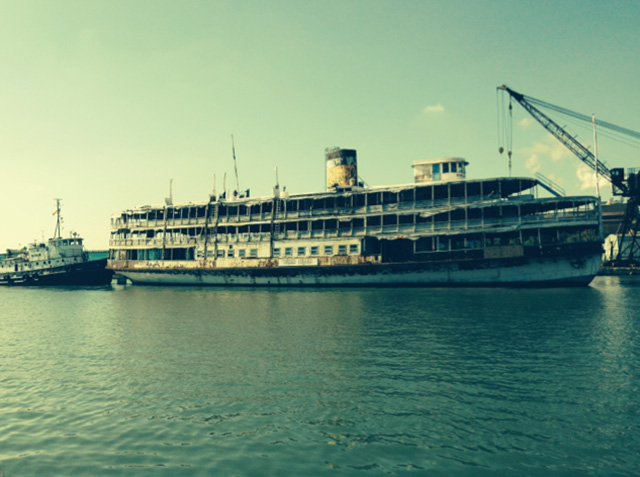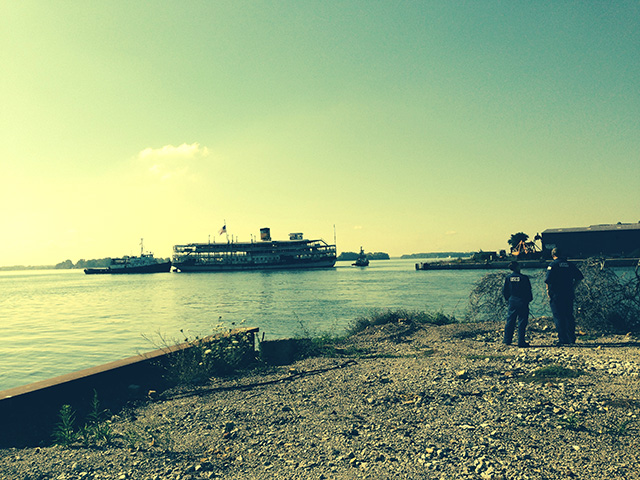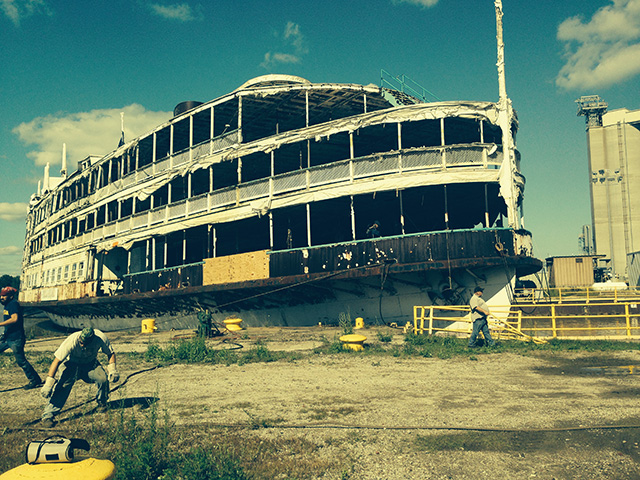Historically, steam vessels ran along the Hudson River, connecting the Hudson Valley with New York City to bring visitors to the natural and cultural resources of both areas. As the Hudson Valley struggles with the post-industrial transition of other rust belt regions, an enterprising and little-known project with a passionate team aims to reconnect the valley with its strategic waterway. Just this week, America’s oldest surviving passenger steamer made the first leg of its journey from Detroit to New York City for service on the Hudson River, functioning as a floating mobile museum and cultural space and restoring a historical transportation link.
After years in disrepair, the iconic SS Columbia is leaving its grave on Detroit’s industrial waterfront and making its way to the Hudson Valley. On September 16th, 2014 the ship started for Toledo where it wintered. In September 2015, it will embark on its long trip up the St. Lawrence River, then down the Atlantic Coast to New York, where restorations will be completed. With the Erie Canal too narrow for the steamer, the relic will have to traverse through Canada before making its way down to New York.
Plans for reviving a Hudson River steamboat began in 2006, when preservationist Richard Anderson hatched the idea to bring the SS Columbia to New York and have her serve again, at an estimated cost of $15 million for restoration. Unfortunately, Anderson passed away in 2013 and will not see his project fulfilled, but the SS Columbia Project, paired with the historic preservation community of Detroit, has passionately gone through with his plan. In Detroit, volunteers partook in restorations, while preservationists, maritime engineers, historians, and civic leaders have also helped the ship begin its journey to New York.

The SS Columbia was used as an excursion vessel for most of the 20th century as a popular recreational boat on the Detroit River, mainly at the Boblo Island amusement park. Famously the first steamboat in the United States with a proper ballroom, the ship was listed on the National Register of Historic Places in 1979. When the park closed in 1993, the SS Columbia was no longer needed for ferrying Detroit patrons north to Boblo. After serving for 90 years, the SS Columbia survived threats to use her for scraps while the ship sat docked outside the Great Lakes Steel Company in Michigan. In 1996, the ship was auctioned off and by 2000, the steamer had significantly deteriorated: paint was chipped, wood rotten, and decks full of holes.

The SS Columbia will winter on a dry dock in Toledo, where she was originally constructed as per designs by naval architect Frank E. Kirby and artist Louis O. Keil.Liz McEnaney, the SS Columbia Project’s Executive Director, told us that the SS Columbia made it the 8-9 knots to Toledo, faster than was expected, down the Detroit River, into Lake Erie, and to the Maumee River.
A woman named Gloria Davis who rode the boat at 6 years old in 1936 called the ship “a floating time machine,” and said “I’m grateful that she is going to have a new life” and “it’s a miracle and testament to her construction and her spirit that she’s still here.”Another Detroit-native reflected on its move: “SS Columbia is the last of her generation, and if anything is worth saving in terms of our heritage in the Great Lakes region it’s her. Sending Columbia to New York is a bittersweet triumph because she could not be saved here in Detroit.”
We’ll be visiting the ship on its journey to New York so stay tuned! Check out the SS Columbia Project’s website and Facebook page for more.
All photos courtesy of Liz McEnaney.






